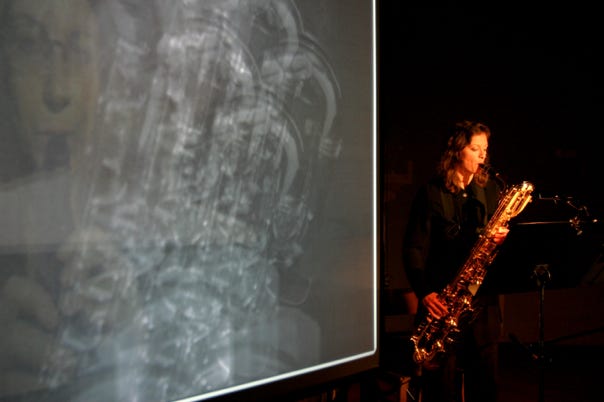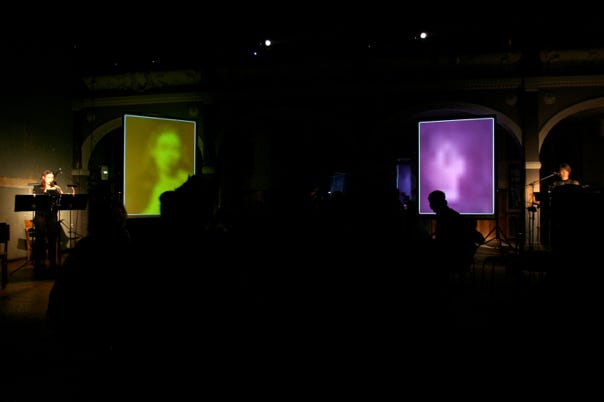RaumStörung
for voice, recorder, baritone saxophone, tuba, analysers, modulators and
synthetic sounds in a computer with SuperCollider, 4 cameras and 4 video beamers with their own
computers and jitter video software.
The musicians stay in fixed places where their activity is recorded and mapped via video camera. The instrumental sounds undergo strong changes in their nature through electronic modulations of themselves. Something comparable happens with the images of the musicians on the screens.
Four projection surfaces are installed on which the actors are depicted via camera and computer and their immediacy is blurred, their character obscured.
The space fluctuates in its appearance on the one hand as a precise, inherently constructed space and on the other hand as a blurred, irritated space. The first case occurs when the musicians are only visible in their immediate form and their acoustic instruments sound through loudspeakers without amplification. The other case manifests itself in a total confusion of the space, in that the musicians appear visually as images on "false" screens, sometimes also delayed and image-modulated, hardly recognisable and additionally subjected to acoustically corresponding spatial and sound modulations via loudspeakers.
In extreme moments, the images take on a life of their own, becoming visual and acoustic art objects that lose their origin.
Both in the video image and in the music, time delays are conceived that range from barely perceptible milliseconds to 17 seconds, in extreme cases even up to months, if the images of a visual kind were pre-produced in the studio.
Limiting the projection surfaces to four medium-size screens is important in order to make the video images objects in the space rather than lining the space.
Networks are formed electronically, both acoustically and visually:
Via microphones, the sounds of the instruments are artificially sent on a journey through four loudspeakers; images of their acoustic origin transport them to virtual places that correspond or contradict their actual ones.
The video technology used also enables such virtualisations on the image level. Mixtures of live material with pre-produced material, modulations, time delays and changes in location create - together with the electro-acoustic level - strong irritations in the perception of the actual musicians' actions.
Within the electronic circuits, an additional network is created: the spectra of the instrumental sounds can directly influence the electroacoustic and video modulations of their own manifestation via real-time sampling, thus forming a kind of back-referenced closed system. In most parts of the composition, the musicians themselves shape their virtual representation on a visual and acoustic level through their playing.
Voice : Ute Wassermann Tuba : Robin Hayward
Flute : Lucia Mense Saxophone : Simone Otto


